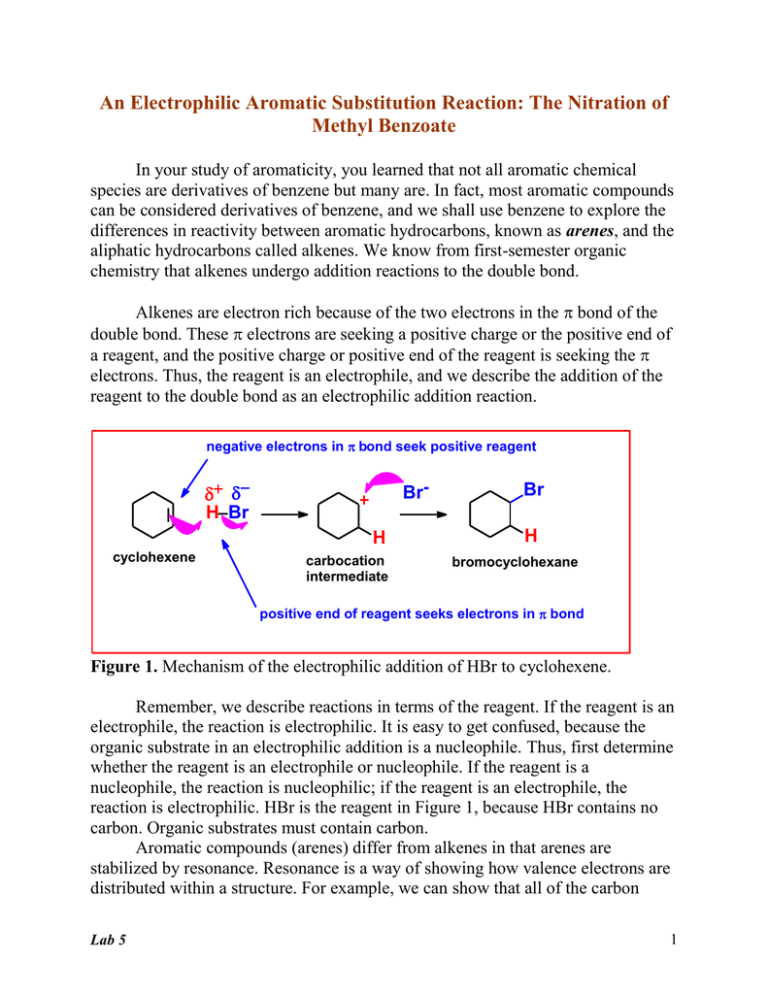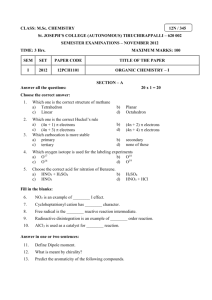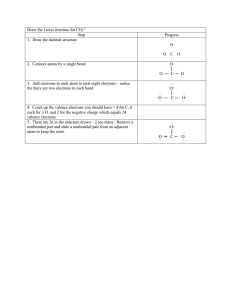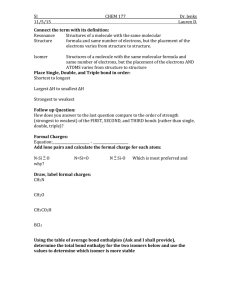An Electrophilic Aromatic Substitution Reaction: The Nitration of Methyl Benzoate
advertisement

An Electrophilic Aromatic Substitution Reaction: The Nitration of Methyl Benzoate In your study of aromaticity, you learned that not all aromatic chemical species are derivatives of benzene but many are. In fact, most aromatic compounds can be considered derivatives of benzene, and we shall use benzene to explore the differences in reactivity between aromatic hydrocarbons, known as arenes, and the aliphatic hydrocarbons called alkenes. We know from first-semester organic chemistry that alkenes undergo addition reactions to the double bond. Alkenes are electron rich because of the two electrons in the bond of the double bond. These electrons are seeking a positive charge or the positive end of a reagent, and the positive charge or positive end of the reagent is seeking the electrons. Thus, the reagent is an electrophile, and we describe the addition of the reagent to the double bond as an electrophilic addition reaction. negative electrons in bond seek positive reagent H Br BrH cyclohexene carbocation intermediate Br H bromocyclohexane positive end of reagent seeks electrons in bond Figure 1. Mechanism of the electrophilic addition of HBr to cyclohexene. Remember, we describe reactions in terms of the reagent. If the reagent is an electrophile, the reaction is electrophilic. It is easy to get confused, because the organic substrate in an electrophilic addition is a nucleophile. Thus, first determine whether the reagent is an electrophile or nucleophile. If the reagent is a nucleophile, the reaction is nucleophilic; if the reagent is an electrophile, the reaction is electrophilic. HBr is the reagent in Figure 1, because HBr contains no carbon. Organic substrates must contain carbon. Aromatic compounds (arenes) differ from alkenes in that arenes are stabilized by resonance. Resonance is a way of showing how valence electrons are distributed within a structure. For example, we can show that all of the carbon Lab 5 1 atoms in benzene are identical by drawing two resonance structures, as shown in Figure 2. We imagine two structures in which the bonds have changed locations, as shown by the curved arrows. Electrons do not actually move. The actual structure is a composite of the two; thus, every carbon atom in benzene is identical in its properties. Figure 2. Resonance structures of benzene. When we can draw equivalent resonance structures, we say the species is resonance stabilized, because it is more stable than a similar structure for which we cannot draw resonance structures. Chemical systems tend to seek energy minima that correspond to stable structures. Thus, aromatic compounds do not normally undergo addition reactions, because that would require them to go from a more stable to less stable structure. See Figure 3. Br + H Br H benzene aromatic 5-bromo-1,3-cyclohexadiene non-aromatic This reaction does not occur, because the product is not aromatic. Figure 3. Hypothetical electrophilic addition to benzene. Arenes undergo substitution reactions that we call electrophilic aromatic substitution reactions because the substrate is aromatic, the reagent is an electrophile or positive species, and a hydrogen atom on the aromatic ring is replaced by the electrophile. The mechanism for an electrophilic aromatic Lab 5 2 substitution is shown in Figure 4 in which E+ represents any electrophile and benzene is the arene organic substrate. H E+ H slow Step 1 H H E fast Step 2 E Figure 4. Mechanism of an electrophilic aromatic substitution. The mechanisms for the five kinds of electrophilic aromatic substitution we cover in CHM 202 are all like the mechanism shown in Figure 4. The electrophile forms a bond to the ring with a pair of electrons from the ring in the slow first step. Then a proton is lost in a fast second step. After Step 1, an H and E are bonded to the same carbon atom. In Step 2, the H departs; hence, the reaction is a substitution. All we need do is show the curved arrows correctly. Curved arrows show how bonds are formed and broken. (i.e., where the electrons that form bonds come from and where the electrons of bonds that are broken go). Look at benzene in Figure 4. The electrons that form a bond with the electrophile E+ come from the benzene ring. Aromaticity is restored by the electrons holding the proton that is lost by substitution of E. Note that only two curved magenta arrows are required to show the mechanism for the overall reaction. The Nitration Reaction Formation of the Electrophile Before the nitration reaction can take place, the electrophile, the positive chemical species that forms a bond with the arene, must be made. The electrophile is the nitronium ion, +NO2. The nitronium ion is formed by a reaction between two strong acids, nitric acid and sulfuric acid. Figure 5 shows the reaction between the two acids to form the electrophile +NO2. Once formed, the +NO2 ion will bond to the arene. Lab 5 3 H O N H O O + H O S O H O N O H nitric acid + O O O O O S O H O sulfuric acid O N O + H O H nitronium ion Figure 5. Formation of the nitronium ion from nitric acid. The nitronium ion is the positive ion or electrophile that substitutes for an H atom on the benzene ring. Thus, in our reaction, +NO2 is the E+ in Figure 4. The mechanism for the nitration of benzene is exactly like the mechanism in Figure 4 in which E+ becomes +NO2. Mechanism for the Nitration of Benzene Figure 6 shows the nitration of benzene. H H benzene +NO 2 H slow Step 1 H NO2 carbocation intermediate fast Step 2 NO2 nitrobenzene Figure 6. Mechanism for the nitration of benzene. In Step 1, a pair of electrons from the arene forms a bond with the nitrogen atom of the nitronium ion, making a carbocation on an adjacent carbon atom. Step 1 is the rate-determining or slow step in the overall reaction. In Step 2, the loss of a proton restores aromaticity to the ring. Curved arrows (magenta color) show where the electron pairs go by pointing at their new location. In Step 1, the first curved arrow starts at the electron pair in benzene and points at the N atom of the nitronium ion. This means that the two electrons form a bond between one of the two carbon atoms it shares initially and the nitrogen atom of the nitronium ion. The other carbon atom that initially shares the bond acquires a positive charge because it no longer shares the bond. At the end of Step 1, the NO2 or nitro group Lab 5 4 is bonded to the ring, and a three-bonded carbon atom in the ring has a positive charge (i.e., it is a carbocation). A carbocation is a carbon atom that has only three bonds and a vacant p orbital. Thus, a carbocation is not a stable chemical species. In Step 2, aromaticity is restored when the pair of electrons from the H atom fills the vacant p orbital of the carbocation. This is shown by the second curved arrow. The final product is nitrobenzene. The hydrogen atom (proton) that leaves in Step 2 is bonded to the same carbon atom as the NO2 group, making the reaction a substitution reaction. Nitration of Methyl Benzoate In our lab reaction, the substrate is methyl benzoate an ester rather than benzene, because benzene is carcinogenic. When a group such as the carbomethoxy group in methyl benzoate is bonded to the benzene ring, the group determines where the electrophile, E+, will bond on the ring. Groups that can donate electron density to the ring are called electron-donating groups, EDGs. Electron donating groups cause the electron density in a benzene ring to be altered so that the carbon atoms ortho and para to the EDG have more electron density than do the carbon atoms meta to the EDG. On the other hand, groups that withdraw electron density from a benzene ring when they are bonded to it are called electron withdrawing groups or EWGs. Electron withdrawing groups alter the electron density of the ring by making the ortho and para carbon atoms positive relative to the carbon atoms meta to the EWG. This means that an electrophile will bond to the ortho or para position of an EDG and meta to an EWG. This is shown in Figure 7. EWG EDG ortho, para director meta director Figure 7. o,p and meta directors. Lab 5 5 We use the concept of resonance to help us show how a group bonded to a benzene ring changes the electron density of the ring. To draw a resonance structure, we are permitted to move either non-bonded (n) or electrons but not change the location of any atoms. When we move electrons, they must have a place to go. Finding a place for either or n electrons to go is the first step is drawing a resonance structure and is the key to determining whether a group is an EDG or an EWG. Consider the structure of methyl benzoate shown in Figure 8 so that its non-bonding electrons are visible. n O C n O CH3 Figure 8. Methyl benzoate. We do not want to memorize whether the carbomethoxy group is an EDG or an EWG; we want to analyze the structure and determine from the structure what kind of group it is. If the group is an EDG, or n electrons labeled as “blue” electrons must be pushed into the ring via a new double bond at the green bond linking the group to the ring. If the group is an EWG, electrons labeled as “red” must be pushed out of the ring via a new double bond at the green bond. Only n or electrons can move. In order to be an EDG, blue electrons must be made to move so that they are pushed into the ring via the green bond that links the group to the ring. Likewise, to be an EWG, red electrons must move out of the ring across the green bond. When n electrons move, they must remain associated with their atom, so they can only make new bonds. When electrons move, they must remain associated with at least one of the atoms that share them. Each oxygen atom can have one, two or three bonds, but must always have eight valence electrons; whereas, carbon can have three or four bonds and either eight or six valence electrons. When a three-bonded carbon has six valence electrons, it is a carbocation with a vacant p orbital. When a three-bonded carbon has eight valence Lab 5 6 electrons, it is a carbanion. Applying these constraint rules to methyl benzoate, we can determine whether it is possible to form a double bond at the green bond (i.e., whether the carbomethoxy group is an EDG or EWG). We find that it is impossible to draw a structure with a double bond to the ring by using the “blue” electrons ( or n electrons outside the ring). However, it is possible to draw a structure with a double bond to the ring by using “red” electrons ( electrons from the ring). If you cannot draw the resonance structures that prove that the CO2Me group is an EWG, then please review the tutorial entitled “Resonance” that accompanies this lab manual. Mechanism for the Nitration of Methyl Benzoate The mechanism for the nitration of methyl benzoate is the same as that shown in Figure 6 except that we must make the NO2 (nitro group) go to a meta position relative to the CO2Me group that is already bonded to the ring. This means that the positive charge in the carbocation intermediate must be on an ortho or para carbon relative to the CO2Me group. CO2Me H H methyl benzoate NO2+ slow CO2Me H Step 1 H NO2 carbocation intermediate CO2Me fast Step 2 NO2 methyl m-nitrobenzoate Figure 9. Mechanism for the nitration of methyl benzoate. Lab 5 7 Procedure Precaution Nitric acid and sulfuric acid are both strong acids that can burn skin. Be careful not to spill either acid on yourself. If you do, wash the area quickly and thoroughly with water. 1. Place a 4-mL conical (V-shaped) reaction vial from a microkit on a balance and tare it to zero. 2. Add 10 drops of methyl benzoate to the reaction vial while the vial is still on the balance. Record the mass of the added methyl benzoate directly on your lab data sheet and then take the vial to your bench. 3. Add 12 drops of concentrated sulfuric acid, H2SO4, to the vial and mix it thoroughly with the methyl benzoate. 4. Attach the condenser form the microkit to the conical vial. 5. Clamp the condenser to a ring stand. The following photo shows a conical vial immersed in an ice-water bath. 6. Prepare and ice-water bath in a 250-mL beaker by adding both ice and water to the beaker. 7. Adjust the condenser so that the reaction vial is immersed in the ice-water bath. This reaction must be kept cold to preclude the formation of unwanted byproducts. Lab 5 8 8. Add six drops of concentrated nitric acid, HNO3, and six drops of concentrated sulfuric acid, H2SO4, to a small test tube. This mixture of concentrated nitric and sulfuric acids is called the nitrating mixture, because both acids are required for a successful nitration. 9. Cool the test tube containing your nitrating mixture in your ice-water bath. 10. Transfer one drop of the cold nitrating mixture to the reaction vial. Instead of unscrewing the reaction vial to add the nitrating mixture, add it through the open tube in the condenser. 11. Carefully swirl the condenser/reaction vial setup to ensure good mixing of the reactants. 12. Add one drop of the nitrating mixture through the condenser about every thirty seconds until all of the nitrating mixture has been added. 13. After all of the nitrating mixture has been added, remove the condenser from the ice-water bath but leave it clamped to the ring stand for about 10 min. 14. Place about two grams of crushed ice in a 50-mL beaker. 15. Carefully pour the reaction mixture from the reaction vial over the crushed ice. The ice is solid water, which will effectively absorb the heat of solvation of the excess acids in the mixture. The ice will melt in the process, and the product is a solid that is insoluble in water. 16. After the ice melts, collect the solid product of methyl m-nitrobenzoate on a Hirsh funnel. 17. Continue the suction until the solid is as dry as possible then record its mass directly on your data sheet. Conduct any addition tests as directed. 18. Wash and rinse all glassware and return it to the microkit or to its proper storage location. Replace the ring stands to their storage locations. Check the balance area. Turn off all balances and return any chemicals to their proper locations. Lab 5 9 Electrophilic Aromatic Substitution Stu No___ Sec___Stu last name_________________________, First___________ 1. What chemical is added to nitric acid and to sulfur trioxide to make them suitable electrophiles for nitrating and sulfonating a benzene ring? Ans._____________________________________ 2. What is the electrophile in the nitration of methyl benzoate? Ans. __________ 3. Draw a resonance structure of chlorobenzene that shows it to be an EDG by resonance. Cl 4. On the basis of your resonance structure in problem 3, is the chloro group an ortho,para or meta director? Ans. _______________________ 5. Show the mechanism for the nitration of bromobenzene, starting with bromobenzene and a nitronium ion. 6. Starting with the structure of nitrobenzene, draw one resonance structure that shows it to be an EWG by resonance. O N Lab 5 O 10 7. Primary carbocations are too unstable (require too much energy) to form in a typical lab reaction. When propyl chloride reacts with benzene in the presence of aluminum chloride, isopropylbenzene is obtained. Write an equation for this reaction. Show the major organic product(s) of the following equations. 8. Cl 2 AlCl3 9. 10. fuming sulfuric acid Br2 CHCl3 Lab 5 11





